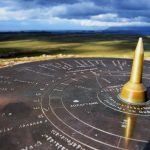Moray, Peru – Inca Laboratory (24.09.17)
Moray, the huge and dramatic whirlpool-shaped Inca terracing, is one of Latin America’s most spectacular sights. It’s a ‘must see’ for anyone travelling through the highland regions of Peru.

Nestled in the hills, 600m above the valley linking Cusco to the Sacred Valley, with distant snow-capped peaks standing guard like sentries over an ancient secret, the magical swirl of co-centric circles draws you in rather like the eyes of Kaa, The Jungle Book’s mesmeric snake, do.
The first time I unexpectedly clapped eyes on Moray, I was dumbfounded by its size, shape and spinning-top setting. Dug into the Andean hillside, with terracing covering areas between 3,200-3,500m above sea level, the ancient amphitheatre-style terracing is widely believed to have been an important Inca agricultural research centre.

Cleverly spread over 300m of altitude, the site’s temperatures vary by as much as 15°C between the higher structures and vast circular basin at the bottom. This remarkable botanical feature allows for a vast agricultural experimentation zone, with, moreover, an ingeniously designed drainage system. It is so well planned that the lower basin never completely floods despite its deep hollow setting.

Research has shown that soil from across the Inca Empire was laid over the different terracing levels. This enabled Inca priest-scientists to experiment with different crops at different altitudes, and was hugely influential on farming efficiency practised across this Andean region.
I highly recommend a visit to Moray, ideally when travelling between Cusco and The Sacred Valley. And, as previously blogged, combined with a high altitude Andean bike ride.

You can get up close and personal with this ancient market garden, where each layer of terracing supports compacted earth, sealed in with neatly constructed stone support walls. Traversing the terracing, visitors can climb up and down the different layers, with original stone step-ladders laid out like an unusual ‘stairway to heaven’ from top to bottom.
The expertise of these traditional farming methods, in this most dramatic of South American landscapes and leading cultures, is reflected in the fact that today, the majority of the world’s food crops originally came from the Andes, with Peru responsible for over 2,000 varieties of potato alone.

















